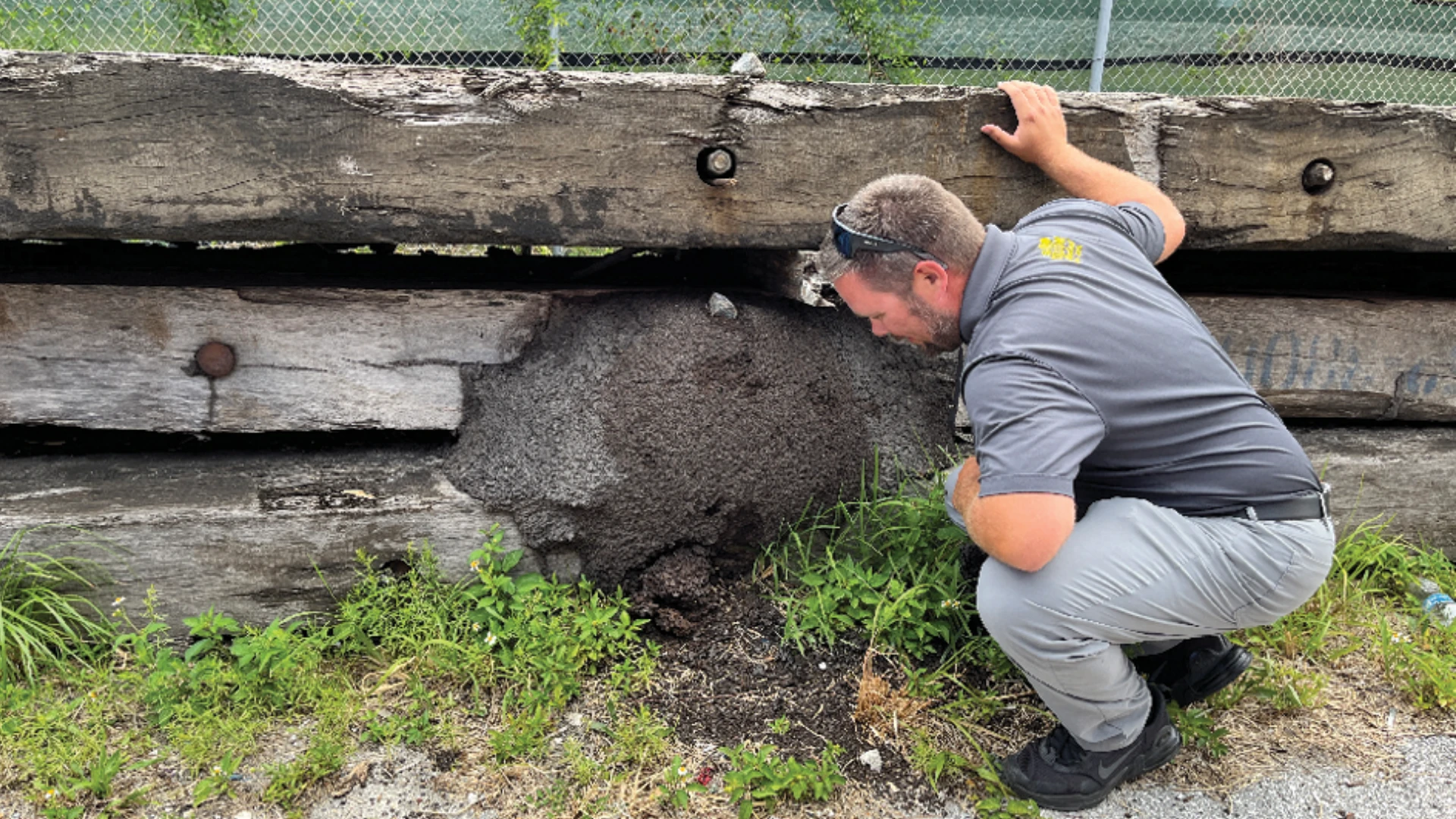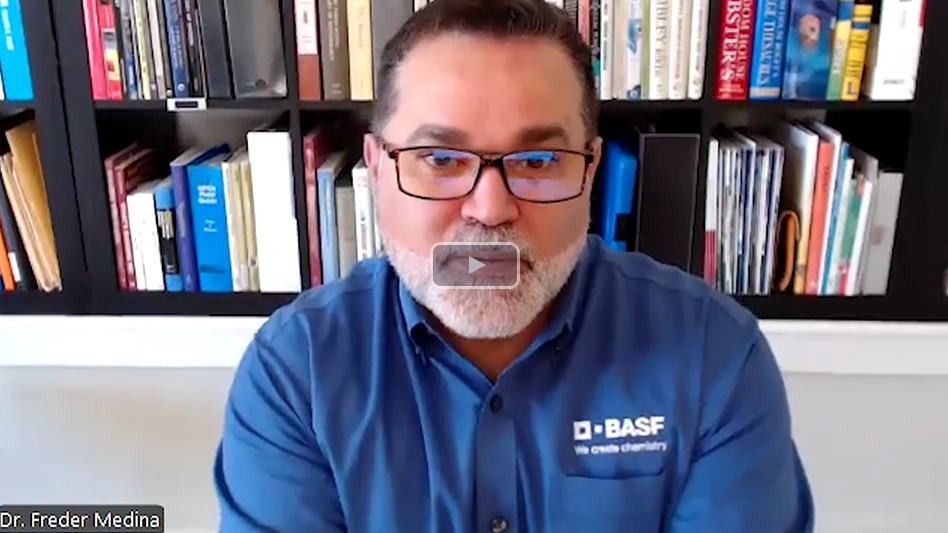WOOD BORER PROBLEM
Q I am working with a homeowner to resolve a wood borer problem. The home is large and about 17 years old. We found termites in the home a few years ago, prior to the sale, and have them under control. However, we found evidence of wood borers and are concerned about the extent of the infestation. The home has lacked exterior wood siding maintenance. There are many old exit holes and we have found larvae and evidence in the band board in the crawlspace. What are these? They do not appear to be old house borers as we first thought.
A The damage indicates that the beetle
causing the damage is a Cerambycid beetle, while some indications in some damage indicate an old house borer. After inspecting the structure and seeing some of the problems that need to be addressed, my conclusion is that there are moisture and wood rot problems in and under some areas of the wood siding and that these wood borers have been attracted here. They appear to have found their way into the cracks and areas under the siding as some of the damage is confined to the underlying wood and the beetles have exited through the siding when mature.
Your approach to treating with a borate as repairs are made and treating the entire crawlspace as a precaution can be a productive method of control. Major renovation of the exterior side of the home that faces the weather is presently being done as siding is removed and wood replace applications can be performed. After the repairs, painting and sealing have been done, there should be no more problems. I would recommend an ongoing inspection program to determine if any area becomes vulnerable to moisture incursion. But the borate application should deter any future infestation of these beetles.
OLD HOUSE BORERS
Q I have seen a mass emergence of Cerambycid beetles from a log home. The number of exit holes and the frass was incredible. I am wondering about the potential re-infestation of these beetles.
A The beetle sent to me by this reader was a flat oak borer. It is in the same family as the old house borer (Cerambycid) as he suspected. The frass of a flat oak borer is actually different from the OHB — there are more pellets and they are drier. This beetle has been found to re-infest and be a particular problem in log homes. Often they are associated with moisture conditions — even the beginning stages of rotting wood. In the scenario he described it sounds like fumigation would be called for. I have seen small infestations controlled by opening areas, using borate solutions and repairing the moisture problems.
TROUBLE WITH TERMITE BAITS
Q I have been using a termite bait system for a few years now. I have a small number of properties that are still having problems. The problem is that either there are no hits in the stations or there is a small hit and then the termites go away. In the meantime, the homes experience swarms — in one case damage is evident; in others there are no signs (i.e., tubing, damage) anywhere. What is your advice?
A The first part of my answer is a question.What do these properties have in common? I have found in investigating bait systems that there are several things that can complicate the monitoring/baiting scenario. Termite activity that is repetitive (that is, there are swarms every year in relatively the same place), indicates a possible infestation that has not been associated with damage or other termite evidence. It would certainly indicate a colony in close proximity but not necessarily in the home. Next, how close can you get monitors to these activity sites? Usually I have found that there are obstacles like patios, concrete slabs from driveways, add-ons, etc. For some reason we are reluctant to core these unless we really have to. Coring these has usually led to a hit within a few months.
Next, do the homeowners overwater their yards, including the monitors? If so, this can slow down the hits. (Although it is popular to say termites are attracted to moisture, they really do not swim well.) Also, what is the distance from the foundation to the monitors? I have had customers say, "We don’t want those stations in the garden." This can complicate the situation. Try to keep those monitors close to the structure beyond the drip edge and not in any previously treated areas. Interestingly, Dow AgroSciences’ new ESP system can find the stations under rocks, so maybe that is the answer if you are using Sentricon. Of course it is more work for the technicians, but they can place rocks over the stations.
Often, when the system has been in the ground for a few years, the urge to spot treat takes over. And why not? Try to alleviate the customers’ concerns — treat areas where termite swarms have appeared, etc. What product do you use? A repellent or a non-repellent? How do you think this treatment affected the termites? Actually, we do not know.
Some pest management professionals claim after treatment they have seen hits. I have too, but I cannot say it would not have happened naturally. Somewhere there is a body of data that may show this, but I have not seen it. In addition, you have to look at your accounts and review these potential problems with your salespeople and service technicians and discuss these issues with the customer before you start the job.
I guess the bottom line is this: if the system has no hits and the homeowner is getting nervous (or you are), then a liquid treatment may be the answer. However, just because there is a treatment, many customers (even though they see no more termites) are still concerned about the "no hit" problem.
The author is president of George Rambo Consulting Services, Central, S.C. Fax questions to him at 864/654-2447 or via e-mail at grambo@pctonline.com.

Explore the October 2002 Issue
Check out more from this issue and find your next story to read.
Latest from Pest Control Technology
- The Evolving World of Electronic Rodent Monitoring
- Back-to-basics Approach for Cockroach Control
- PPMA Encourages PMPs to Take Part in Termite Awareness Week
- Moneypenny is a Provider of Virtual Receptionists
- Video: Top 10 PCT Photo Contest Finalists
- Massey Services Expands with Southeast Commercial Region
- Pest Management Foundation Announces Kevin J. Burns Scholarship
- How to Identify Clover Mites





